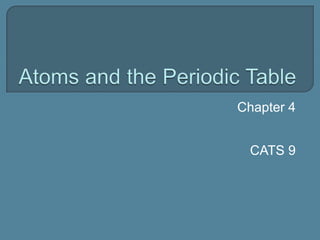
Atomic Structure and the Periodic Table
- 1. Chapter 4 CATS 9
- 2. Section 1: Atomic Structure Section 2: A Guided Tour of the Periodic Table Section 3: Families of Elements Section 4: Using Moles to Count Atoms
- 3. Pages 104 - 110 Homework: Read Section 1 Vocabulary: Complete Section 1 & 2 Vocabulary Crossword Atom Element Upcoming Events: Nucleus Next Week - Elements Proton Quiz (1-10) Neutron Electron Orbital Valence Electron
- 4. Atoms are tiny units that determine the properties of all matter. • An element is matter that is made up of only one type of atom.
- 5. 4th Century BCE: Democritus stated that the universe was made up of invisible units called atoms. Democritus was unable to provide evidence of his claims.
- 6. John Dalton’s • English teacher in the early nineteenth century who stated the following about matter: 1. Matter is made up of atoms 2. Atoms cannot be divided into smaller pieces 3. All the atoms of an element are exactly alike 4. Different elements are made of different kinds of atoms.
- 7. Nucleus: Small dense area in the center of an atom with a positive charge. Particle Charge Mass (kg) Location Proton +1 1.67x10-27 In nucleus Neutron 0 1.67x10-27 In nucleus Electron -1 9.11x10-31 Moving around nucleus A helium atom has 2 protons, 2 neutrons, and 2 electrons. What is the overall charge of the atom?
- 8. How do scientists make How can you determine the models of things they can’t inside structure of a box? see? They do experiments, gather as much information Goals: as possible, and then try to • Observe the motion of a fit the information together in marble inside a closed box some kind of pattern to • Infer the structure of the make inferences. From the divisions inside the box data and inferences, they create a model that fits all their data. Often, they find they must revise their models when more data becomes available.
- 9. Procedures: Conclude and Apply: 1. Record the number of the box 1. How did your model of the inside given to you on the top of your of the box compare with the paper. DO NOT TAKE THE LID actual inside? OFF. 2. Could you have used any other 2. Lift the box. Tilt the box. Gently test to gather more information? shake it. Record any 3. How is an observation different observations you would like and from an inference? make a sketch of the way you think the marble in the box is rolling. 3. Use your observations to infer what the inside of the box looks like. 4. Compare your inference with those of students who had the same box as you. Revise your sketch if needed.
- 10. Part Charge Found
- 11. Dalton Thompson Rutherford Bohr Electron Cloud
- 12. John Dalton (1808) Dalton pictured the atom as a sphere that was the same throughout.
- 13. J.J. Thompson (1897) Instead of a solid ball, Thomson pictured a sphere of positive charge with negatively charged electrons spread evenly among the positive charge.
- 14. Ernest Rutherford (1906) Tested Thompson’s model to check it’s validity. By shooting alpha particles (positively charges) at a gold film, he found that some of the particles shot backwards instead of going through the film, as expected. He hypothesized that the almost all of the mass of an atom is crammed into the center called the nucleus.
- 15. Niels Bohr (1913) Suggested that electrons in an atom move in set paths around the nucleus (like planets orbit the Sun). Each electron had a certain amount of energy, determined by it’s path. The electrons must gain or lose energy to move betweens levels (elevator model).
- 16. Electron Cloud A new model of the atom was created to suggest that electrons move much like waves, instead of having a definite path. Electrons in this model move in an area around the nucleus called the electron cloud. Electrons tend to stay close to the nucleus because of the attraction to positive charges there.
- 17. Energy Levels Electrons with different amounts of energy exist in different energy levels. The number of filled energy levels an atom has depends on the number of electrons. (page 108)
- 18. Orbitals The region in an atom where electrons are likely to be found are called orbitals. These orbitals are found in the energy levels, and electrons will fill the lowest energy level first. The four types of orbitals are s, p, d, and f. S – 2 electrons P – 6 electrons D – 10 electrons F – 14 electrons
- 19. Orbitals
- 20. An electron in the outermost energy level is called a valence electron. These determine the chemical properties of an atom and determines how it can form bonds.
- 21. 1. Label the energy levels below with the number of electrons in each: Nucleus 1 2 3 4
- 22. 1. How many valence electrons will oxygen have? 2. How many valence electrons will boron have?
- 23. Pages 111 - 119 Homework: Read Section 2 Vocabulary: Periodic Law Upcoming Events: Period Next Week - Elements Quiz Group (1-10) Ion Atomic Number Mass Number Isotope Atomic Mass Unit (amu) Average Atomic Mass
- 25. Pages 120 - 128 Homework: Read Section 3 Vocabulary: Complete Section 3 & 4 Vocabulary Crossword Metal Nonmetal Upcoming Events: Semiconductor Next Week - Elements Alkali Metal Quiz (1-10) Alkaline-Earth metal Transition Metal Halogen Noble Gas
- 26. Pages 128 - 134 Homework: Read Section 4 Vocabulary: Complete Chapter 4 Study Guide Mole Avagadro’s constant Upcoming Events: Molar Mass Next Week - Elements Conversion Factor Quiz (1-10)
